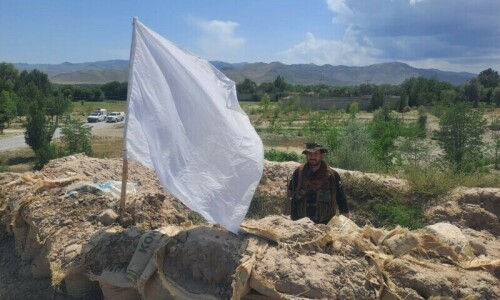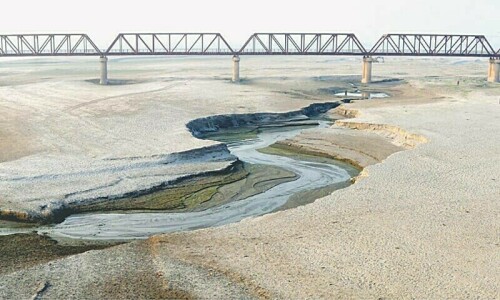 ON 26 JULY 2002, progress on the Lyari Expressway was reviewed at a high level meeting under the chairmanship of the Governor of Sindh. Promoters and executors of the project, comprising top officials of the National Highway Authority, provincial and city governments participated.
ON 26 JULY 2002, progress on the Lyari Expressway was reviewed at a high level meeting under the chairmanship of the Governor of Sindh. Promoters and executors of the project, comprising top officials of the National Highway Authority, provincial and city governments participated.
In the proceedings, the project was termed as entirely beneficial to all the area residents as well as the locality of Lyari. According to the executing team, some 150,000 people residing in the river bed will be relocated to better and healthy environment. Concern was shown against people involved in propaganda against the project.
In other words, the meeting ended with a decision to maintain the status quo and to go ahead with the demolitions and destructions unleashed by the project implementing team. It was disappointing to find out that the top functionaries of the government are not prepared to address findings of the scientific research which is continuously carried out to bring forth objective situation of the project. It is however important to review these factual realities In the larger interest of the affected persons and all the other stockholders.
The Lyari Expressway project was conceived around 1989 by a group of citizens as an option for reducing the load of transport in the inner-city district of Karachi. It was proposed as an elevated transit way on Lyari river culminating into Super Highway at Sohrab Goth. This plan was presented to the then concerned officials who accepted it in principle. However citizen groups and some professionals raised serious concerns about its construction which was based on contextual research. Displacement of settlements, businesses, educational and social facilities; anticipated rise in the atmospheric pollution level; lack of possibility of creating cargo/truck terminal spaces; already proposed and initiated project of Karachi Northern Bypass (as a parallel to the Lyari Expressway itself) and inappropriate location of congested Sohrab Goth as the terminating point of the expressway were some of the key concerns cited against the initiation of the project. However despite repeated representations, in June 2000, the government decided to construct the expressway. The activity began by evicting the settlements through bulldozing on the existing Lyari River in January 2002. According to the government’s own calculations, substantial damage to the existing property will be done in all 11,964 housing units, 42 religious places including mosques, churches and mandirs, and 1035 shops / workshops / factories will be destroyed. Extrapolating government’s estimates, the livelihood of about 6000 families will be completely destroyed. Urban Resource Centre (URC), a non-profit research organization which is conducting studies on these issues for several years, has estimated the losses to be far greater. According to the findings of URC, 25000 houses have been marked for demolition along the proposed corridor. Commercial enterprise numbering 3600 will be demolished breaking the employment line of 40,000 families.
The residents of the under threat communities approached the Sindh High Court for relief. The SHC stayed the demolition of the settlement till 13 August 2002 in some earmarked localities, although demolitions are still continuing in some adjoining areas. For this legal recourse, the community members had to contribute over Rs.3 millions - a colossal drag on their already fragile household incomes. Several demonstrations were held on different occasions. The political parties, civil society organizations and community based organizations categorically rejected the project and the destruction it is bringing about. Review of the outskirt location of Baldia - where re-settlers are supposed to be provided plots for compensation - is either encroached or in a totally run down status. Basic utilities and infrastructure will take several years for connection.
An important aspect of the project are the various claims and disclosures made by the administration. Most of them lie unfulfilled or simply unattended. The administration agreed to provide project details for public review. However these details are neither disclosed to the affected stockholders nor any effort made to satisfy such affected persons who have themselves lodged requests for up-to-date information including the bulldozing/demolition schedule, physical outline of the expressway alignment and the expected land use details which shall emerge as an outcome, if the expressway project is completed. The city government announced to form a nine member expert committee to review the project. This committee was never activated since its announcement made in March 2002. It was also decided that the list of affected families will be published but it awaits implementation. The project administration claims that suitable alternate land parcels will be provided to affecters. In actual, options of disputed or semi raw land is being offered without proper demarcations and basic utilities. This offer is least attractive as the affecters presently reside in a better locality.
By the initiation of this project and the manner in which it is implemented, the project administration has seemingly made a mock of the national and international conventions. United Nations Conference on Human Settlements in 1996 recognized the universal commitment to adequate housing. Another UN body, the UN Committee on Economic, Social and Cultural Rights (UNCESR) adopted a resolution against eviction. Pakistan, being a long standing recipient of development doles, has assured to comply with such principles on more than one occasion. In reality, bulldozing is taking place without restraint.
It is a dilemma in our developmental practice that the developmental projects are elite focused and adversely affect the poorer sections of the society. What is expected to bring a ‘relief in traffic’ is approaching the poor as total economic and social collapse due to destruction of employment as well as demolition of houses. Both the residences and work places had been built step by step through the hard earned money, and certainly without government-support. It is expected that the net economic worth of demolitions along Lyari Expressway shall be Rs02 billion.
Construction of Lyari Expressway is leading to an increase in homelessness among the poor. The project administration simply withes to absolve itself from its obligation by allotting a small plot in a far flung area. Creation of proper re-settlement scheme is now mandatory according to the guidelines issued by the World Bank and other international agencies. It will also not provide any relief in the domain of employment, razed down due to government action.
An empirical review of the project clearly reveals the victims and beneficiaries. The area residents who shall lose their shelter; factory and enterprise owners who had to shed their means of income; employees who shall lose their jobs and employment; communities facing direct relocation from age old habitats to new places; school going children especially minors losing their enrolment are few of the direct victim categories of the project. The contracting agency that has acquired this multi billion rupee contract; developers and builders who shall get prized parcels of land for high density commercial development; consulting firms that prepared various documents for the project and the city government which expects of having “successful” project to its credit, are the direct beneficiaries of the project.
Lyari Expressway is a project that will only benefit a few and harm a vast number of people. It must be objectively reviewed. Further progress on the project should only be made after all the concerns of the related stakeholders are addressed. Otherwise this project might become the “epitaph of participatory development through grass roots involvement”, which the government claims at the top of its voice!
















































Dear visitor, the comments section is undergoing an overhaul and will return soon.